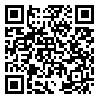
 , Ali Ashraf Jamshidi *
, Ali Ashraf Jamshidi * 
 2, Leila Abbasi3
2, Leila Abbasi3 
 , Saeedeh Seyyed-Mohseni1
, Saeedeh Seyyed-Mohseni1 
 , Mohammad Kamali1
, Mohammad Kamali1 

2- Rehabilitation Research Center, Tehran University of Medical Sciences, ,
3- Shiraz University of Medical Sciences
Objective: In this study, using nonlinear dynamics methods, dynamic stability index was used to assess the effect of perturbation training on anterior cruciate ligament (ACL) deficient patients.
Materials & Methods: Non-randomized sampling was employed to recruit male athletes with at least 6 months elapsed after their ACL lesion. Using tilt boards, 10 sessions of perturbation training were done. Lower limb kinematics were recorded using electrogoniometers during walking before and after the training. Knee kinematic data of 60 gait cycles was used to calculate dynamic stability index. Time series were reconstructed in five dimensions then finite-time lyapunov exponent was calculated for seven subjects before and after training. Wilcoxon nonparametric test was used to assess the impact of training.
Results: The value of the dynamic stability index before and after training was computed as and , respectively. Statistical analysis showed that dynamic stability index of gait improved significantly in ACL deficient patients after perturbation training (P=0.016).
Conclusion: Perturbation training improved the dynamic stability of ACL deficient patients. Therefore using nonlinear dynamics methods one can establish an effective theoretical basis for designing and assessment of specific ACL rehabilitation. Such methods could be used in functional assessment of other interventions that affects body movement such as gait.
Received: 27/02/2010 | Accepted: 15/04/2013 | Published: 15/04/2013
| Rights and permissions | |
 |
This work is licensed under a Creative Commons Attribution-NonCommercial 4.0 International License. |
